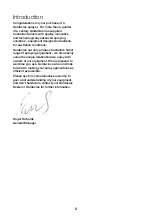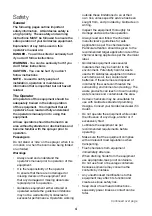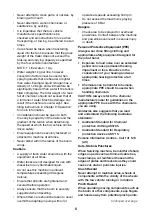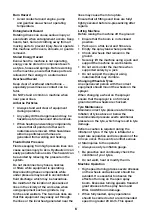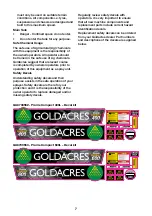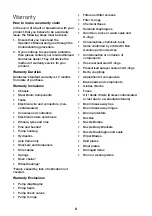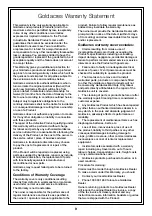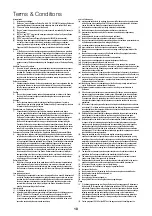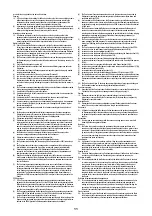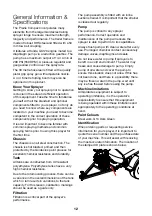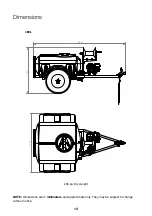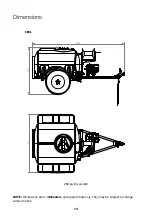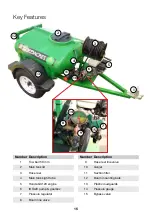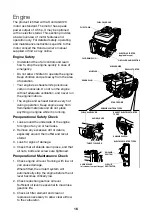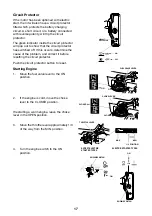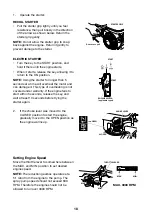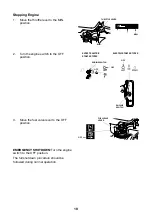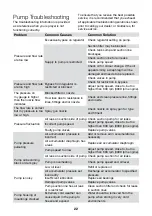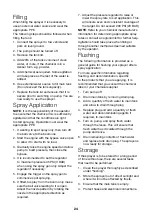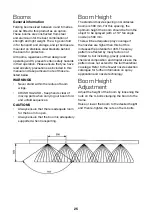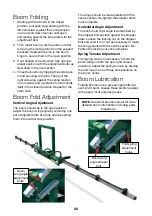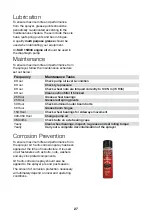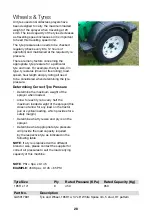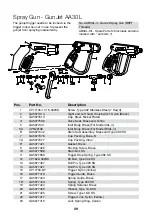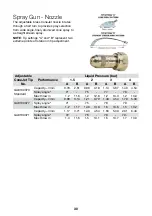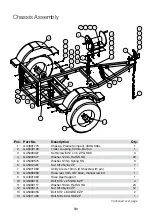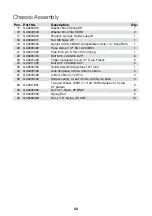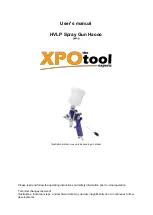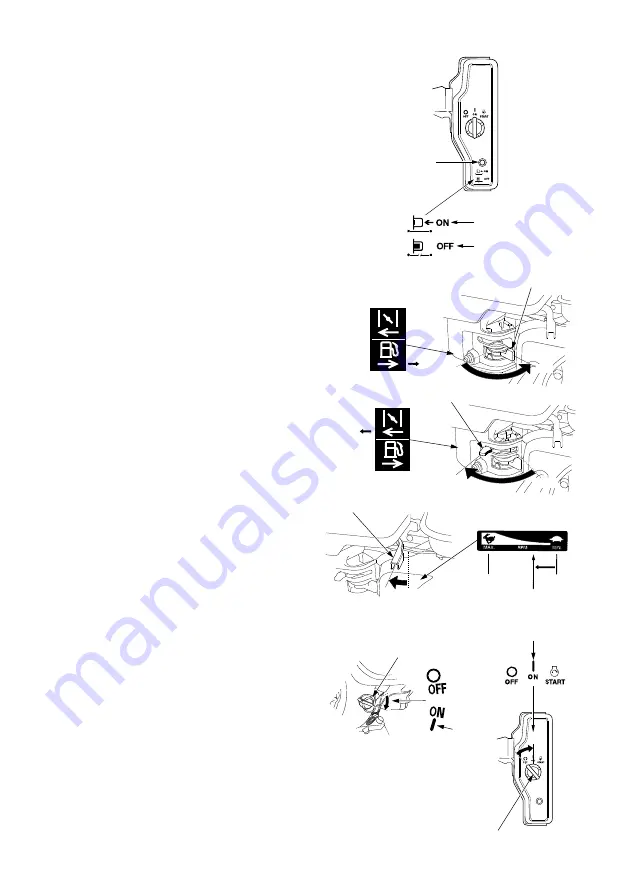
17
Circuit Protector
If the motor has been optioned with electric
start, then it will also have a circuit protector
fitted which protects the battery charging
circuit. A short circuit, or a battery connected
with reverse polarity, will trip the circuit
protector.
The green indicator inside the circuit protector
will pop out to show that the circuit protector
has switched off. If this occurs, determine the
cause of the problem, and correct it before
resetting the circuit protector.
Push the circuit protector button to reset.
Starting Engine
1. Move the fuel valve lever to the ON
position.
2. If the engine is cold, move the choke
lever to the CLOSED position.
If restarting a warm engine, leave the choke
lever in the OPEN position.
3. Move the throttle lever approximately 1/3
of the way from the MIN. position.
4.
Turn the engine switch to the ON
position.
ENGLISH
3
COMPONENT & CONTROL LOCATIONS
FEATURES
OIL ALERT
®
SYSTEM (applicable types)
‘‘Oil Alert is a registered trademark in the United States’’
The Oil Alert system is designed to prevent engine damage caused
by an insufficient amount of oil in the crankcase. Before the oil
level in the crankcase can fall below a safe limit, the Oil Alert
system will automatically stop the engine (the engine switch will
remain in the ON position).
If the engine stops and will not restart, check the engine oil level
(see page 8) before troubleshooting in other areas.
CIRCUIT PROTECTOR (applicable types)
The circuit protector protects the
battery charging circuit. A short
circuit, or a battery connected with
reverse polarity, will trip the circuit
protector.
The green indicator inside the circuit
protector will pop out to show that the
circuit protector has switched off. If
this occurs, determine the cause of
the problem, and correct it before
resetting the circuit protector.
Push the circuit protector button to
reset.
FUEL FILLER CAP
FUEL TANK
OIL DRAIN PLUG
ELECTRIC STARTER
(applicable type)
OIL FILLER CAP/DIPSTICK
RECOIL STARTER
AIR CLEANER
MUFFLER
SPARK PLUG
STARTER GRIP
ENGINE CONTROL TYPES
FUEL VALVE LEVER
CHOKE LEVER
EXCEPT ELECTRIC STARTER
TYPES
ENGINE SWITCH
THROTTLE LEVER
CHOKE LEVER
(air cleaner low profile type)
ELECTRIC STARTER TYPES
ENGINE
SWITCH
CIRCUIT
PROTECTOR
CIRCUIT
PROTECTOR
ON
OFF
37Z4V6100.fm 3 ページ 2018年10月4日 木曜日 午後1時54分
4
ENGLISH
BEFORE OPERATION CHECKS
IS YOUR ENGINE READY TO GO?
For your safety, to ensure compliance with environmental
regulations, and to maximize the service life of your equipment, it is
very important to take a few moments before you operate the
engine to check its condition. Be sure to take care of any problem
you find, or have your servicing dealer correct it, before you
operate the engine.
Before beginning your pre-operation checks, be sure the engine is
level and the engine switch is in the OFF position.
Always check the following items before you start the engine:
Check the General Condition of the Engine
1. Look around and underneath the engine for signs of oil or
gasoline leaks.
2. Remove any excessive dirt or debris, especially around the
muffler and recoil starter.
3. Look for signs of damage.
4. Check that all shields and covers are in place, and all nuts,
bolts, and screws are tightened.
Check the Engine
1. Check the fuel level (see page 8). Starting with a full tank will
help to eliminate or reduce operating interruptions for refueling.
2. Check the engine oil level (see page 8). Running the engine with
a low oil level can cause engine damage.
The Oil Alert system (applicable types) will automatically stop
the engine before the oil level falls below safe limits. However,
to avoid the inconvenience of an unexpected shutdown, always
check the engine oil level before startup.
3. Check the reduction case oil level on applicable types (see page
9). Oil is essential to reduction case operation and long life.
4. Check the air filter element (see page 10). A dirty air filter
element will restrict air flow to the carburetor, reducing engine
performance.
5. Check the equipment powered by this engine.
Review the instructions provided with the equipment powered
by this engine for any precautions and procedures that should
be followed before engine startup.
OPERATION
SAFE OPERATING PRECAUTIONS
Before operating the engine for the first time, please review the
SAFETY INFORMATION
section on page 2 and the
BEFORE
OPERATION CHECKS
on page 4.
Carbon Monoxide Hazards
For your safety, do not operate the engine in an enclosed area such
as a garage. Your engine’s exhaust contains poisonous carbon
monoxide gas that can collect rapidly in an enclosed area and
cause illness or death.
Review the instructions provided with the equipment powered by
this engine for any safety precautions that should be observed with
engine startup, shutdown, or operation.
Do not operate the engine on slopes greater than 20° (36%).
STARTING THE ENGINE
1. Move the fuel valve lever to the ON position.
2. To start a cold engine, move the choke lever to the CLOSED
position.
To restart a warm engine, leave the choke lever in the OPEN
position.
Some engine applications use a remote-mounted choke control
rather than the engine-mounted choke lever shown here. Refer
to the instructions provided by the equipment manufacturer.
Failure to properly maintain this engine, or failing to
correct a problem before operation, could result in a
significant malfunction.
Some malfunctions can seriously hurt or kill you.
Always perform a pre-operation inspection before
each operation and correct any problems.
Exhaust contains poisonous carbon monoxide gas
that can build up to dangerous levels in closed areas.
Breathing carbon monoxide can cause
unconsciousness or death.
Never run the engine in a closed, or even partly closed
area.
FUEL VALVE LEVER
ON
OFF
ON
CHOKE LEVER
CLOSED
CLOSED
OPEN
37Z4V6100.fm 4 ページ 2018年10月4日 木曜日 午後1時54分
4
ENGLISH
BEFORE OPERATION CHECKS
IS YOUR ENGINE READY TO GO?
For your safety, to ensure compliance with environmental
regulations, and to maximize the service life of your equipment, it is
very important to take a few moments before you operate the
engine to check its condition. Be sure to take care of any problem
you find, or have your servicing dealer correct it, before you
operate the engine.
Before beginning your pre-operation checks, be sure the engine is
level and the engine switch is in the OFF position.
Always check the following items before you start the engine:
Check the General Condition of the Engine
1. Look around and underneath the engine for signs of oil or
gasoline leaks.
2. Remove any excessive dirt or debris, especially around the
muffler and recoil starter.
3. Look for signs of damage.
4. Check that all shields and covers are in place, and all nuts,
bolts, and screws are tightened.
Check the Engine
1. Check the fuel level (see page 8). Starting with a full tank will
help to eliminate or reduce operating interruptions for refueling.
2. Check the engine oil level (see page 8). Running the engine with
a low oil level can cause engine damage.
The Oil Alert system (applicable types) will automatically stop
the engine before the oil level falls below safe limits. However,
to avoid the inconvenience of an unexpected shutdown, always
check the engine oil level before startup.
3. Check the reduction case oil level on applicable types (see page
9). Oil is essential to reduction case operation and long life.
4. Check the air filter element (see page 10). A dirty air filter
element will restrict air flow to the carburetor, reducing engine
performance.
5. Check the equipment powered by this engine.
Review the instructions provided with the equipment powered
by this engine for any precautions and procedures that should
be followed before engine startup.
OPERATION
SAFE OPERATING PRECAUTIONS
Before operating the engine for the first time, please review the
SAFETY INFORMATION
section on page 2 and the
BEFORE
OPERATION CHECKS
on page 4.
Carbon Monoxide Hazards
For your safety, do not operate the engine in an enclosed area such
as a garage. Your engine’s exhaust contains poisonous carbon
monoxide gas that can collect rapidly in an enclosed area and
cause illness or death.
Review the instructions provided with the equipment powered by
this engine for any safety precautions that should be observed with
engine startup, shutdown, or operation.
Do not operate the engine on slopes greater than 20° (36%).
STARTING THE ENGINE
1. Move the fuel valve lever to the ON position.
2. To start a cold engine, move the choke lever to the CLOSED
position.
To restart a warm engine, leave the choke lever in the OPEN
position.
Some engine applications use a remote-mounted choke control
rather than the engine-mounted choke lever shown here. Refer
to the instructions provided by the equipment manufacturer.
Failure to properly maintain this engine, or failing to
correct a problem before operation, could result in a
significant malfunction.
Some malfunctions can seriously hurt or kill you.
Always perform a pre-operation inspection before
each operation and correct any problems.
Exhaust contains poisonous carbon monoxide gas
that can build up to dangerous levels in closed areas.
Breathing carbon monoxide can cause
unconsciousness or death.
Never run the engine in a closed, or even partly closed
area.
FUEL VALVE LEVER
ON
OFF
ON
CHOKE LEVER
CLOSED
CLOSED
OPEN
37Z4V6100.fm 4 ページ 2018年10月4日 木曜日 午後1時54分
ENGLISH
5
3. Move the throttle lever away from the MIN. position, about 1/3
of the way toward the MAX. position.
Some engine applications use a remote-mounted throttle control
rather than the engine-mounted throttle lever shown here. Refer
to the instructions provided by the equipment manufacturer.
4. Turn the engine switch to the ON position.
5. Operate the starter.
RECOIL STARTER:
Pull the starter grip lightly until you feel resistance, then pull
briskly in the direction of the arrow as shown below. Return the
starter grip gently.
Do not allow the starter grip to snap back against the engine.
Return it gently to prevent damage to the starter.
ELECTRIC STARTER (applicable types):
Turn the key to the START position,
and hold it there until the engine
starts.
If the engine fails to start within 5
seconds, release the key, and wait at
least 10 seconds before operating the
starter again.
Using the electric starter for more
than 5 seconds at a time will overheat
the starter motor and can damage it.
This type of overheating is not
covered under warranty.
When the engine starts, release the
key, allowing it to return to the ON
position.
6. If the choke lever was moved to the CLOSED position to start
the engine, gradually move it to the OPEN position as the
engine warms up.
THROTTLE LEVER
MAX.
MIN.
1/3 POSITION
MIN.
EXCEPT ELECTRIC
STARTER TYPES
ELECTRIC STARTER TYPES
ON
ENGINE SWITCH
ON
ENGINE SWITCH
ON
ON
STARTER GRIP
Direction to pull
START
START
ENGINE SWITCH
(applicable types)
OPEN
CHOKE LEVER
CLOSED
OPEN
37Z4V6100.fm ページ 2018年10月4日 木曜日 午後1時54分
ENGLISH
5
3. Move the throttle lever away from the MIN. position, about 1/3
of the way toward the MAX. position.
Some engine applications use a remote-mounted throttle control
rather than the engine-mounted throttle lever shown here. Refer
to the instructions provided by the equipment manufacturer.
4. Turn the engine switch to the ON position.
5. Operate the starter.
RECOIL STARTER:
Pull the starter grip lightly until you feel resistance, then pull
briskly in the direction of the arrow as shown below. Return the
starter grip gently.
Do not allow the starter grip to snap back against the engine.
Return it gently to prevent damage to the starter.
ELECTRIC STARTER (applicable types):
Turn the key to the START position,
and hold it there until the engine
starts.
If the engine fails to start within 5
seconds, release the key, and wait at
least 10 seconds before operating the
starter again.
Using the electric starter for more
than 5 seconds at a time will overheat
the starter motor and can damage it.
This type of overheating is not
covered under warranty.
When the engine starts, release the
key, allowing it to return to the ON
position.
6. If the choke lever was moved to the CLOSED position to start
the engine, gradually move it to the OPEN position as the
engine warms up.
THROTTLE LEVER
MAX.
MIN.
1/3 POSITION
MIN.
EXCEPT ELECTRIC
STARTER TYPES
ELECTRIC STARTER TYPES
ON
ENGINE SWITCH
ON
ENGINE SWITCH
ON
ON
STARTER GRIP
Direction to pull
START
START
ENGINE SWITCH
(applicable types)
OPEN
CHOKE LEVER
CLOSED
OPEN
37Z4V6100.fm ページ 2018年10月4日 木曜日 午後1時54分

